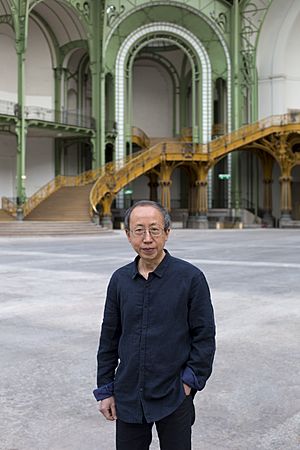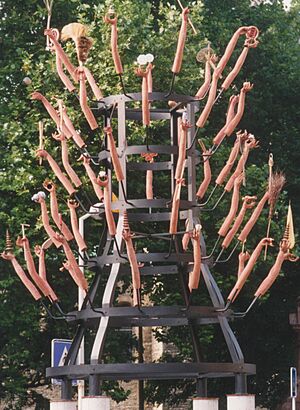Huang Yong Ping facts for kids
Huang Yong Ping (Chinese: 黄永砯; born February 18, 1954 – died October 20, 2019) was a famous Chinese-French artist. He was known as one of the most important avant-garde (new and experimental) artists from China during his time.
Born in Xiamen, China, Huang Yong Ping was seen as a very bold and thought-provoking artist in the 1980s. He taught himself a lot about art. Some of his first ideas came from artists like Joseph Beuys, John Cage, and Marcel Duchamp.
After graduating from art school in 1982, he started a group called Xiamen Dada in 1986. Huang's art changed over time, exploring ideas like being "anti-art" or "anti-history." In 1989, when he was 35, Huang went to Paris for a big art show called Magiciens de la terre. He decided to live in France after that. Many of his artworks are very large, so they are not easy to buy or sell at art auctions.
In 1999, Huang represented France at the Venice Biennale, a major international art exhibition. In 2016, his huge artwork "Empires" was shown at the Grand Palais in Paris.
Xiamen Dada was an art group Huang Yong Ping started in 1986 with friends like Zha Lixiong and Liu Yiling. They were a very modern and experimental group. To protest against traditional art ideas, they even publicly burned their own artworks! After this, the group stopped showing their art in public.
Huang Yong Ping worked with art galleries in New York, Paris, and Beijing. He passed away in Paris in 2019 at the age of 65.
Contents
Art and Ideas
Huang Yong Ping used many different ideas from Chinese and Western philosophies in his art. These included Chan Buddhism, Taoism, and Dada. The Dada art movement helped him create the Xiamen Dada group.
There are many similarities between Chan Buddhism and Dada. People often say, "Chan is Dada, Dada is Chan." Both ideas focus on how art looks and how we see reality. They both suggest that things are always changing. Huang's use of these ideas shows how different cultures can share and mix their thoughts in art. You can see this in his works like “A Concise History of Modern Art” after Two Minutes in the Washing Machine.
Early Artworks
Roulette-Series: Art by Chance
The Roulette-Series was a project Huang Yong Ping worked on from 1985 to 1988. It included three sets of portable (movable) roulettes, each with six spinning parts.
In these artworks, Huang wanted to create art using chance and luck, not just his own feelings. He used dice, roulette wheels, and other tools to decide how his abstract paintings would look. These tools determined everything, from the colors to where each part of the artwork went. Huang believed that we cannot escape our destiny, and that destiny is connected to accidents and chance.
His art often changed from his first ideas. This series was a good example of that. Huang wanted to move away from showing his own feelings in art. So, he let outside forces, like the spin of a roulette wheel or the roll of dice, decide the final look of his pieces.
Artist Marcel Duchamp greatly influenced these works. Huang not only removed personal taste and added randomness, but he also made portable roulettes, just like Duchamp did. Huang also looked at ideas from a thinker named Wittgenstein. Huang saw his art in three ways:
- Art as a process: "The artwork is bigger than the thought behind it."
- Conceptual art: "The thought is bigger than the artwork." (This seems to go against the first idea!)
- "Eastern Spirit": This refers to the ideas of Taoism and Chan Buddhism.
Huang had a special way of making his paintings. He divided his canvas into eight sections, matching an eight-section turntable. He rolled dice to choose materials and used the turntables to decide how the pieces would be placed together.
Huang once said, "Every rule suggests an anti-rule, every reason suggests an anti-reason, every choice suggests an anti-choice. So, he believes: 'However much art there is, so much anti-art exists.'"
A Concise History of Modern Art after Two Minutes in the Washing Machine
A Concise History of Modern Art after Two Minutes in the Washing Machine is a simple project with a deep meaning. For this piece, Huang took two famous art history books – one Chinese and one English – and put them in a washing machine for two minutes. What came out was a pile of wet paper pulp, which he then displayed on a wooden box.
Huang wanted to show how he could erase the differences between old traditions and new modern ideas, which were often seen as coming from the East and West. The paper pulp showed how he was breaking down the separation between these two different art styles. He said this was his way of answering a big question that many Chinese artists faced: how to find a place between tradition and modern times, and between East and West.
This artwork is similar to A "Book Washing" Project, which he did three years earlier at his home in Xiamen. In that project, he took all the books from his bookshelf, washed them, and then stuck the pulp back onto the wall. Both projects had the same idea: to challenge how we think about art history by destroying books.
After Leaving China
After the Tiananmen Square massacre happened in China in 1989, Huang Yong Ping was in Paris for an exhibition. He decided not to go back to China. After this, his artworks changed a lot. They started to focus more on Taoist and Buddhist ideas, and he became more involved with Western culture.
House of Oracles: A Look Back at Huang's Art
The House of Oracles Retrospective was a big exhibition that showed many of Huang's artworks. It traveled to several art centers, including the Walker Art Center in the U.S. (2005-2006), the Massachusetts Museum of Contemporary Art (2006-2007), the Vancouver Art Gallery in Canada (2007), and the Ullens Center for Contemporary Art in Beijing (2008).
This exhibition showed how Huang's sculptures and installations mixed traditional objects and images with modern ideas. He was inspired by artists like Joseph Beuys and John Cage, as well as Chinese art and philosophy.
The House of Oracles featured over forty of Huang Yong Ping's most important works from the past two decades. These included Bat Project II (2002), The Nightmare of King George V (2002), and Python (2000).
A famous art curator named Fei Dawei said that this exhibition was very important. It helped introduce Huang Yong Ping, one of the best Chinese artists, to audiences in America, Canada, and China.
Huang's artworks often showed historical events and how political power influenced things. For example, The Nightmare of King George V showed a hunting trip by King George V in 1911. Bat Project II was about a U.S. spy plane that crashed into a Chinese fighter jet, causing political problems.
100 Arms of Guan-yin
In 1996 and 1997, Huang Yong Ping showed his sculpture "100 Arms of Guan-yin" at major art events in Europe. The Guanyin figure is a Buddhist deity (a god-like figure) often shown with many arms.
Huang Yong Ping created his own version of 100 Arms of Guan-yin. He placed mannequin arms holding different objects onto a metal structure. This metal structure was a giant version of a famous artwork by Marcel Duchamp called Bottle Rack.
In 2008, Huang's work was shown in his first solo exhibition in Norway, at the Astrup Fearnley museum of modern art in Oslo.
For his first solo show in the UK, at the Barbican Art Gallery in London, Huang Yong Ping made a new artwork. It explored the history between Britain and China in the 1800s. The exhibition was called Frolic, named after a ship that carried goods between British India, China, and Great Britain. It was on display from June 25 to September 21, 2008.
Serpent d'océan
In 2012, Huang's serpent d'océan was put in place in Saint-Brevin-les-Pins, France. This is a huge sculpture that looks like the skeleton of a giant sea serpent.
Exhibitions
Selected Solo Shows
- 2016
- "Monumenta," Grand Palais, Paris;
- "Wolfgang Hahn Prize,” Museum Ludwig, Cologne, Germany;
- “Bâton Serpent III: Spur Track to the Left,” Power Station of Art, Shanghai.
- 2015
- “Huang Yong Ping: Bâton Serpent II,” Red Brick Art Museum, Beijing
- 2014
- “Les Mues,” HAB Galerie – Hangar à Bananes, Nantes, France;
- “Huang Yong Ping: Bâton Serpent,” Maxxi, Rome.
- 2013
- “Amoy/Xiamen,” Museum of Contemporary Art, Lyon, France;
- “Abbottabad,” Hôtel de Gallifet, Aix-en-Provence, France.
- 2012
- “Circus,” Gladstone Gallery, New York;
- “Bugarach,” Galerie Kamel Mennour, Paris;
- “Lille 3000, Fantastic,” Musée de l’Hospice Comtesse, Lille, France.
- 2011
- “Huang Yong Ping,” Nottingham Contemporary, Nottingham, England.
- 2010
- “Huang Yong Ping,” Musée Océanographique de Monaco, Monte Carlo, Monaco.
- 2009
- "Huang Yong Ping: Arche 2009,” Ecole Nationale Supérieure des Beaux-Arts, Paris;
- “Huang Yong Ping: Tower Snake,” Gladstone Gallery, New York;
- “Huang Yong Ping: Caverne,” Kamel Mennour, Paris.
- 2008
- House of Oracles: A Huang Yong Ping Retrospective, UCCA in Beijing
- 2007
- “Huang Yong Ping,” Bernier and Eliades, Athens;
- “Huang Yong Ping: From C to P,” Gladstone Gallery, New York.
- 2006
- “Pantheon,” Centre International d'art et du Paysage de l'ile de Vassiviere, l’ile de Vassiviere, France;
- “Les Mains de Bouddha,” Galerie Anne de Villepoix, Paris.
- 2005
- House of Oracles, Walker Art Center, Minneapolis, U.S.A
- 2003
- “Huang Yong Ping,” Massachusetts Museum of Contemporary Art, North Adams, Massachusetts;
- “Huang Yong Ping,” Beacon Project Space, Beacon, New York;
- “Huang Yong Ping,” Fundacion NMAC, Cadiz, Spain;
- “Huang Yong Ping,” Groningen, The Netherlands;
- “Huang Yong Ping,” Musée Dominique Vivant Denon, Chalon-sur-Saône, France.
- 2002
- Xian Wu, Art & Public, Geneva, Switzerland
- "Om Mani Padme Hum," Barbara Gladstone Gallery, New York, U.S.A.
- 2000
- "Taigong fishing, Willing to Bite the Bait," Jack Tilton Gallery, New York, U.S.A.
Awards and Honors
- Officer of the Order of Arts and Letters (2015) - This is a special award from the French government for people who have done great things in art and literature.



